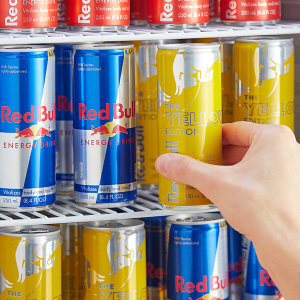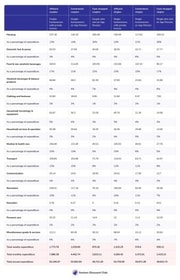Seniors warned! Here's why energy drinks are now linked to permanent nerve damage
By
Maan
- Replies 0
Concerns have been raised over a common ingredient hidden in energy drinks.
Doctors have warned that some Australians may be consuming far more than they realise.
Now, regulators are being urged to act before the problem spirals further.
Vitamin B6, also known as pyridoxine, was vital for brain and nerve health in small amounts.
It occurred naturally in foods such as fish, poultry, potatoes, and avocados, with the recommended daily intake for adults in Australia set between 1.3mg and 1.7mg.
But energy drinks like Red Bull and Monster were often fortified with manufactured B6 to enhance focus and energy, pushing intake far beyond natural dietary levels.
A 250ml can of Red Bull contained 5mg of B6, while a 500ml can of Mother carried 4.3mg, and a 500ml can of BSC Energy packed in 10mg.
This meant a single drink could provide more than six times the recommended daily allowance.
Although these drinks complied with the Food Standards Australia New Zealand (FSANZ) limit of 10mg per day—set when Red Bull first arrived in the country—doctors said consumers were at risk when energy drinks were combined with supplements.
Many vitamin products and fortified foods, including protein bars, cereals, magnesium, and zinc supplements, also contained B6.
The Therapeutic Goods Administration (TGA) reported a surge in B6 toxicity cases last month, with 170 confirmed across the nation and many more suspected to be undiagnosed.
The TGA warned that nerve damage could occur at doses below 50mg a day.
It recommended that supplements containing more than 50mg of B6 be pulled from open sale and placed behind pharmacy counters.
A TGA delegate also suggested FSANZ should review the 10mg energy drink threshold, given the rising risk of people consuming multiple B6-heavy products.
‘Typical consumption patterns mean people are getting much higher doses, not just from individual products but multiple products,’ dietitian and GP Terri-Lynne South told ABC’s 7.30.
Dr South added: ‘For the energy drinks containing 10mg of B6—if they were vitamin supplements—they’d have to show a warning on the label.’
She stressed that supplementing with B6 should only occur if a deficiency or risk of deficiency was proven.
It’s not just energy drinks that carry hidden risks—vitamins and supplements can quietly build up in the body too.
In some cases, what seems like a healthy choice may actually trigger painful and lasting side effects.
One recent case has shown just how easily things can go wrong when it comes to vitamin B6 intake.
Read more: Are you overdosing on this vitamin without even knowing it? Hidden dangers to watch out for

How many Australians might already be living with undiagnosed B6 toxicity without realising the cause?
Doctors have warned that some Australians may be consuming far more than they realise.
Now, regulators are being urged to act before the problem spirals further.
Vitamin B6, also known as pyridoxine, was vital for brain and nerve health in small amounts.
It occurred naturally in foods such as fish, poultry, potatoes, and avocados, with the recommended daily intake for adults in Australia set between 1.3mg and 1.7mg.
But energy drinks like Red Bull and Monster were often fortified with manufactured B6 to enhance focus and energy, pushing intake far beyond natural dietary levels.
A 250ml can of Red Bull contained 5mg of B6, while a 500ml can of Mother carried 4.3mg, and a 500ml can of BSC Energy packed in 10mg.
This meant a single drink could provide more than six times the recommended daily allowance.
Although these drinks complied with the Food Standards Australia New Zealand (FSANZ) limit of 10mg per day—set when Red Bull first arrived in the country—doctors said consumers were at risk when energy drinks were combined with supplements.
Many vitamin products and fortified foods, including protein bars, cereals, magnesium, and zinc supplements, also contained B6.
The Therapeutic Goods Administration (TGA) reported a surge in B6 toxicity cases last month, with 170 confirmed across the nation and many more suspected to be undiagnosed.
The TGA warned that nerve damage could occur at doses below 50mg a day.
It recommended that supplements containing more than 50mg of B6 be pulled from open sale and placed behind pharmacy counters.
A TGA delegate also suggested FSANZ should review the 10mg energy drink threshold, given the rising risk of people consuming multiple B6-heavy products.
‘Typical consumption patterns mean people are getting much higher doses, not just from individual products but multiple products,’ dietitian and GP Terri-Lynne South told ABC’s 7.30.
Dr South added: ‘For the energy drinks containing 10mg of B6—if they were vitamin supplements—they’d have to show a warning on the label.’
She stressed that supplementing with B6 should only occur if a deficiency or risk of deficiency was proven.
It’s not just energy drinks that carry hidden risks—vitamins and supplements can quietly build up in the body too.
In some cases, what seems like a healthy choice may actually trigger painful and lasting side effects.
One recent case has shown just how easily things can go wrong when it comes to vitamin B6 intake.
Read more: Are you overdosing on this vitamin without even knowing it? Hidden dangers to watch out for
Key Takeaways
- Vitamin B6 was essential in small amounts but dangerous in excess.
- Energy drinks such as Red Bull, Mother, and BSC Energy contained high B6 levels.
- The TGA recorded a spike in B6 toxicity cases, with 170 confirmed nationwide.
- Health experts called for stricter labelling and tighter FSANZ limits on energy drinks.
How many Australians might already be living with undiagnosed B6 toxicity without realising the cause?








